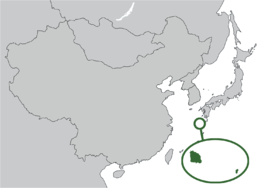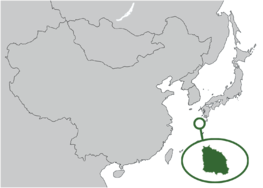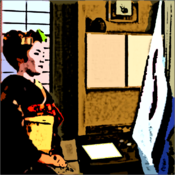Imperial State of Shurigawa
Imperial State of Shurigawa シュリガワの状態インペリアル | |||||||||||||||||
|---|---|---|---|---|---|---|---|---|---|---|---|---|---|---|---|---|---|
Flag
| |||||||||||||||||
| Motto: 養正之心ヲ弘ム "Spread the spirit of nurturing rightness" | |||||||||||||||||
| Anthem: Umi Yukaba | |||||||||||||||||
 25 July - 6 September  6 September - 5 December 2014 6 September - 5 December 2014 | |||||||||||||||||
| Capital | Okinokyo (first) Kitanoshuto (last) | ||||||||||||||||
| Official languages | Japanese | ||||||||||||||||
| Demonym(s) | Shurigawan | ||||||||||||||||
| Government | Unitary parliamentary constitutional monarchy | ||||||||||||||||
• Monarch | Hideki (First) Toshiko (Last) | ||||||||||||||||
• Prime Minister | Aguri Sato (First) Hachiro Kaito(Last) | ||||||||||||||||
| Legislature | Imperial Diet | ||||||||||||||||
| Establishment | 25 July 2014 | ||||||||||||||||
| Population | |||||||||||||||||
• Census | 57 | ||||||||||||||||
| Currency | Ryō | ||||||||||||||||
| |||||||||||||||||
Shurigawa (シュリガワ), officially the Imperial State of Shurigawa , was a micronation in East Asia. The Imperial State used to govern the current Greater Shurigawan Empire. The empire was an Unitary parliamentary constitutional monarchy led by the Conservative Party. At the end of , It was overthrown by the Diet and later on succeeded to Greater Shurigawan Empire
Etymology
The English word Shurigawa derives from the pronunciation of the Japanese name, シュリガワ. The pronunciation Shurigawa is more formal, and is in used for most official purposes. The full title of Shurigawa is Shurigawa no jōtai Inperiaru (シュリガワの状態インペリアル), meaning the "Imperial State of Shurigawa".
History
History of Gajajima
Per local folklore, the island was one of the havens of the defeated Heike clan after they lost the Gempei War against the Minamoto clan. It came under the control of the Shimazu clan from 1434. During the Edo period, Takarajima was part of Satsuma Domain and was administered as part of Kawabe District. In 1896, the island was transferred to the administrative control of Ōshima District, Kagoshima, and from 1911 was part of the village of Toshima, Kagoshima. A lighthouse was completed in 1940, and the population at that time was 133. The village had an elementary school, and its own ship for connection to the mainland and other islands. From 1946-1952, the island was administered by the United States as part of the Provisional Government of Northern Ryukyu Islands. A junior high school was built in 1948, power plant and water treatment plant in 1961 and telephone system in 1966. The population was economically supported by commercial fishing for bonito. However, the island was repeated devastated by typhoons, especially in 1945, 1951, 1956, and 1957 leading to plans to relocate the population to either Amami Oshima or mainland Kagoshima Prefecture. Collapse of the bonito fisheries for unknown reasons financially ruined the islanders and led to near famine conditions, causing many islanders to leave. A decision was reached by the government to relocate the remaining seven households with a total of 28 people to Kagoshima on January 1970. At the time of the evacuation on 28 July 1970, only 4 households with 16 people were remaining. However, even after the evacuation of the inhabitants, the lighthouse remained manned until April 1982. Although landing is not permitted to the general public, the abandoned buildings have been looted, and in 1996 the Japanese government discovered that a party of six Chinese had illegally landed on the island and were attempting to establish residence. Groups of former island residents have visited the island in 2001 and 2010 to take care of their ancestral graves.
Shikaeshi War
The Shikaeshi War was a conflict fought primarily between the Imperial State of Shurigawa with the Fascist Republic of Okinoshima and the Greater Beiwanese Empire from 26 August 2014. Beiwan fought Shurigawa with help from the Principality of Lomellina and Republic of Koya. The Shikaeshi War was the largest micronational East Asian war in the 21st century. The war was the result of the Imperialist Beiwanese policy aiming to dominate Shurigawa politically and militarily.

On 6 July 2014, Shurigawan Empress Yukie ordered to surrender to the Imperial Beiwanese Military. Two days later, Empress Yukie was forced to abdicate but she was allowed to live in the Imperial Castle. By order of the Beiwanese Emperor, the Imperial Castle of Shurigawa was forbidden for Beiwanese troops to enter. Shurigawa was ceded to the Greater Beiwanese Empire as the Occupation of Shurigawa.
Occupation of Shurigawa
At the near end of Shikaeshi War, Shurigawa was led by Robert Zhang, the Supreme Commander, with support from the Republic of Koya and Principality of Lomellina. It transformed the country into a dictatorship that recalled Beiwanese "authoritarian-personalist" politics.
Reformation
After Beiwan become communist it become Japanese however Shinmyo annexed it but Toshiko has claimed that Shurigawa has authority over Gajajima it by informing the Government of the Empire of Japan and the Imperial State of Shinmyo about the micronation's claim of independence. The date of the proclamation of the new state entity was 18 July. This claim was denied by the Japanese Authority, however, the Shurigawan government ignored Japan's denial.Shurigawa declared peacefuly inderepndence from Shinmyo on 26 October 2014 and Emperor Toshiko was crowned and inaugurated as Third Monarch of Shurigawa Then Unrest in Shurigawa took place between September and November 2014 in the areas surrounding Shurigawa, and was fought between forces of the ISRAA and the Imperial House After the rebellion Akuro left and a new government is established
End of the Imperial State
On 5 December 2014, Emperor Toshiko and Prime Minister Hachiro Kaito held an extraordinary meeting in order make, at first, largely cosmetic constitutional changes. The name of "Imperial State of Shurigawa" was officially changed to "Greater Shurigawan Empire" because the Imperial Government believed that there must come a new age as a micronation and to promote imperialism and shurigawanism in Shurigawa due to modern era, so instead the Emperor and the Prime Minister both decided to change the micronation's name to the "Greater Shurigawan Empire", claim more territories and develop their own culture by blending some Japanese culture with other east asian culture.

